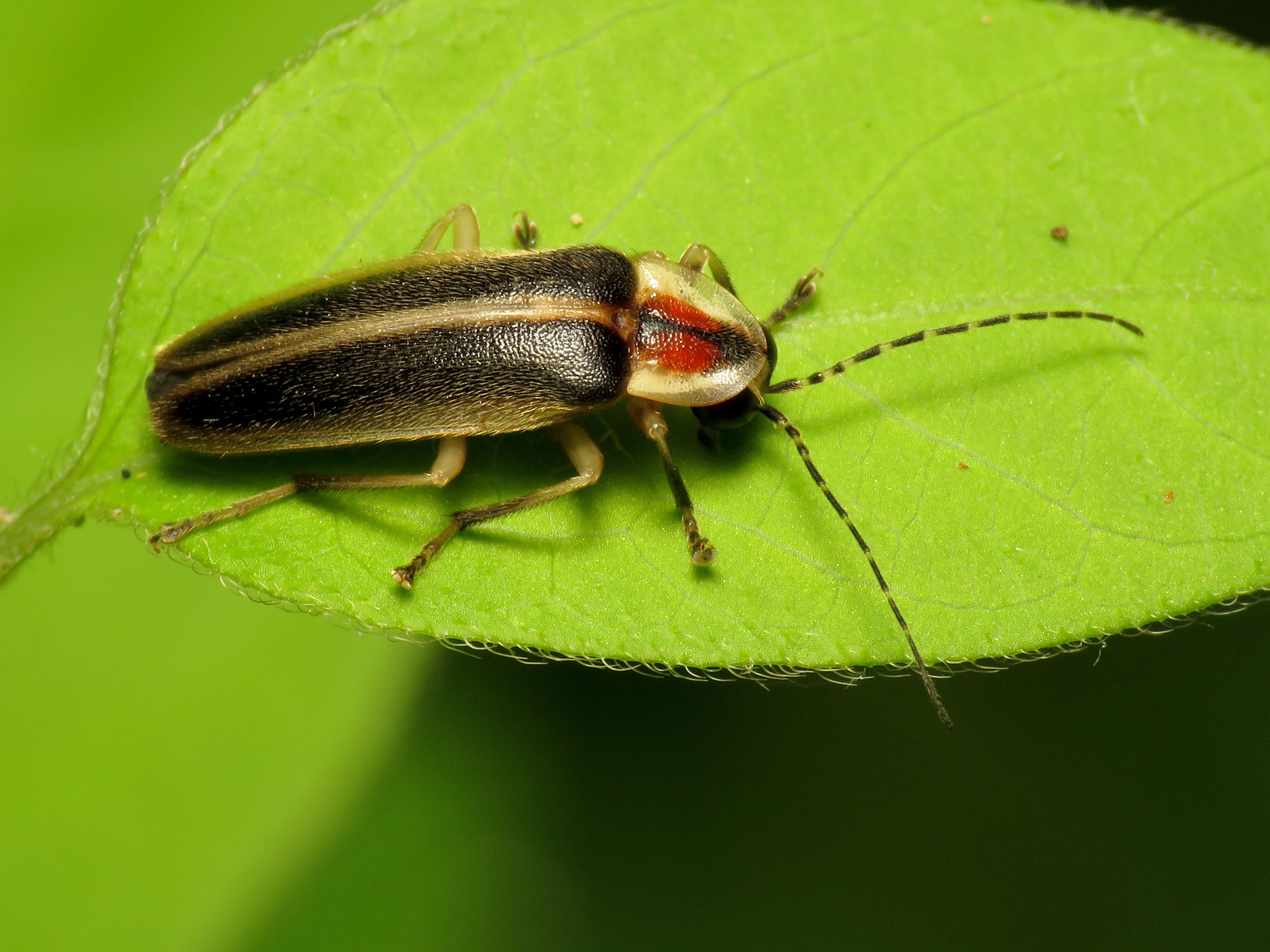
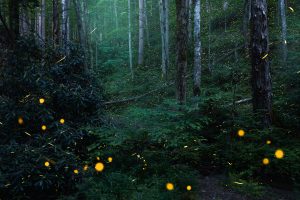
For many people who grew up in the eastern United States, the soft yellow blink of fireflies drifting over dusky fields and lawns is synonymous with summer, a nostalgic symbol of warmth and childhood. But few would guess that the common eastern firefly (Photinus pyralis) is one of more than two thousand firefly species worldwide.
Of those species, 19 are known to make their home in Great Smoky Mountains National Park—and the true number is likely even higher. For many species, flash patterns from the male fireflies’ courtship displays are key to identification, and each species flashes only in specific locations at specific times of night during a finite period each year.
“In a 500,000-acre park, if you haven’t been to a certain area at 9:30 at night, you might very well miss a different species that could be occurring there,” said Smokies entomologist Becky Nichols.
Even the Smokies’ most well-known firefly species, the synchronous firefly (Photinus carolinus), managed to fly under the radar until 1992, when Lynn Faust responded to an article in Science News claiming that there were no synchronous fireflies anywhere in the western hemisphere. Faust, who would go on to become one of the world’s foremost firefly experts, told the scientists named in the article about the light show she’d been enjoying for years at her in-laws’ cabin in the Smokies at Elkmont.
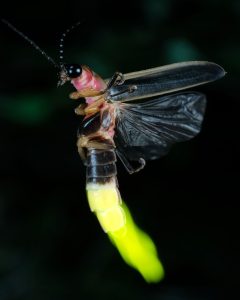
Every year, usually in early June, the male fireflies would fly through the forest along the Little River, blinking in unison—five to eight flashes of yellow light, followed by eight to ten seconds of darkness, on repeat—from full dark around 9:30 p.m. until midnight. The display captivated Faust and her family. Over the last three decades, the show has become such a sensation that park officials had to institute a lottery system for visitors wishing to witness the peak display at Elkmont. Otherwise, massive crowds would trample the area and harm the insects they had come to see.
While people find firefly displays enchanting, for the insects it’s about function, not form. The flashing lights come from the males—a specific pattern designed to let females of their species know that they’re there and would like to mate. Females, typically laying low in the grass or forest floor, offer a weaker light in response, a different pattern from that used by the males, signaling their location to potential partners. Then they mate and lay eggs that hatch into larvae, which will spend the next one or two years underground, eating and growing until it’s time to emerge as adults.
Witnessing a peak display is a “magical” experience, said Jim Costa, an entomologist and professor at Western Carolina University, but most people don’t realize that synchronous fireflies thrive in suitable habitats throughout the Appalachians. While there are “untold gazillions” in pristine places like Elkmont, smaller populations survive “even in somewhat developed areas where there’s still some intact woodland.”
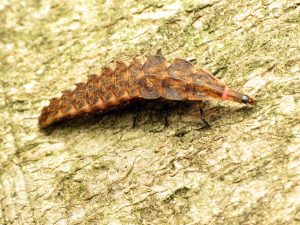
Nor are synchronous fireflies the only ones that light up the Smoky Mountain night in May and June. There are the blue ghosts (Phausis reticulata), named for the green-blue glow they emit as they cruise the forest floor, tracing a path of ghostly light. Then there’s the candle firefly (Pyractomena angulata), whose appearance is marked by an orange, candle-like flicker above head-level in the forest. Found in open fields, the Cinco de Mayo firefly, also called the four-flasher (Photuris quadrifulgens), offers its distinctive four-flash pattern, followed by four seconds of darkness. Flashbulbs, Christmas lights, and heebie jeebie fireflies (Photuris versicolor complex) light up the trees.
Many fireflies don’t eat at all once they leave the larval stage, devoting their ephemeral adult life to finding a mate. But females of the Photuris genus are “femme fatale” predators, mimicking the flashes of other firefly species to lure in the randy males upon which they prey. A single female Photuris can consume up to five male fireflies per day. But even this behavior likely stems from the instinct to procreate, Faust said. Other firefly species produce certain defensive chemicals that Photuris fireflies don’t.
“They can incorporate the chemicals they get from the prey into their own eggs,” she said, “and that helps their eggs, and later their babies, be chemically protected.”
While flashes in the dark may seem a logical requirement to be considered a firefly, a startling number of firefly species don’t flash at all. Of the 19 firefly species confirmed in the Smokies, only 13 have male lanterns, and thus nighttime displays.
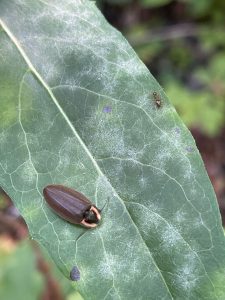
“One definition is fireflies have to glow as larvae,” Faust explained.
All firefly larvae can glow, and even in species with no male display, females often emit a dim light. Meanwhile, in other species, both sexes are completely dark. One of these so-called dark fireflies, the winter firefly (Ellychnia corrusca) is among the region’s most abundant. Unlike most of its relatives, which tend to come out in late spring and early summer, adults of this species appear in fall to late winter, and are often found warming themselves on the sunny side of a tree trunk.
“The ones that don’t light up are relying more on what ancestrally they relied on, and what most insects rely on, and that’s pheromones,” said Costa, who directs Highlands Biological Station and is working on an insect field guide soon to be published by Smokies Life. “With those species, you find their eyes tend to be a little smaller and their antennae a bit bigger compared to their relatives that do light up.”
Despite being some of the most treasured insects on the planet, in some ways fireflies remain an enigma.
“We’re still at the level of not even knowing exactly where they are in the US, each species, or the most basic things about their lives,” Faust said.
But we know enough to know that many firefly species are under threat. New development churns up the ground, destroying any larvae living there, and pesticides harm them too.
“A lot of populations are lost in the larval phase, so no one’s even aware of it until the next summer, when there’s nothing flashing,” Faust said.
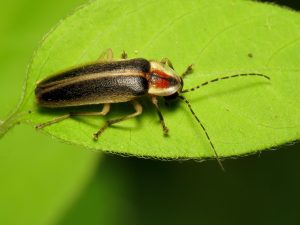
For adult fireflies, light pollution is a real problem, preventing males and females from finding each other to mate. People can help, Nichols said, by refraining from excessive use of pesticides, allowing some of their yard to remain undeveloped and unmanicured, and making simple changes to reduce light pollution—using timers, motion detectors, shields that direct lights downward, and amber bulbs instead of bright white-blue lights. Addressing these threats is important to prevent the loss of a natural marvel, and to protect the ecosystem as a whole.
“It’s death by a thousand cuts, these little bits and pieces eating away at the integrity of their populations,” Costa said. “Obviously, we would be far the poorer in an almost spiritual sense if they were gone because we love them, because they’re beautiful. But we don’t really know the magnitude of the detriment to our ecology if we lost them.”
A synchronous firefly named Pho and a Photuris versicolor, dubbed the Deadly Giant, are main characters in a forthcoming illustrated children’s book, Pho: A Smokies Firefly Adventure, written by Mary Arkiszewski, illustrated by Emma Oxford, and set for release by Smokies Life later this month.
The Great Smokies Welcome Center is located on U.S. 321 in Townsend, TN, 2 miles from the west entrance to Great Smoky Mountains National Park. Visitors can get information about things to see and do in and around the national park and shop from a wide selection of books, gifts, and other Smokies merchandise. Daily, weekly, and annual parking tags for the national park are also available.